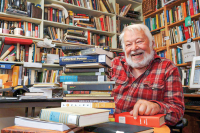Speaking for the trees: Waynesville launches arboretum effort

As manager of Waynesville’s urban forest, it’s safe to say that Jonathan Yates likes trees. So when Diane Kornse of the Mountain View Garden Club approached him last fall to ask if the town had any project in the wings that the club could help tackle, Yates was ready with an answer.
“I said, ‘Actually, I do have an idea I’ve had for years, but it would really require something like a garden club to make it happen,’” Yates recounted.
The concept? Transform Waynesville’s 44-acre recreation park into an arboretum, a garden of trees packed with biological diversity and environmental learning opportunities. Yates’ enthusiasm quickly spread to Kornse and from there to the rest of the 24-member garden club. Since that initial conversation, the town and the garden club have been busy with joint planning efforts, preparing to break ground on the first stage of the project within a month.
The serenity garden, to be planted with native shrubs and plants purchased by the garden club, will go in the bit of grassy space between Shelton Branch and the dog park. It’s planned as a kidney-shaped garden to include a walking path branching off from the main greenway trail and a bench for people to stop and take in the view. The disc golf ring that’s there now will be moved across the creek, and a raised berm will encircle the area to create a room-like effect.
“It’s going to look very, very nice,” Kornse said. “Right there by the creek, it’s very beautiful.”
The plans are already done — the town will donate materials such as mulch, soil and stone for the walkway — and Kornse expects to start site work in the next three to four weeks, finishing the planting by November so the garden will be all set to spring to life next season.
Related Items
The big picture
The garden will certainly add beauty to the park, but it’ s just one small piece of the overall vision that arboretum supporters hope to pursue into the future.
“That’s really the beginning of what will be some long-term fundraising and long-term PR and long-term commitment from both the town of Waynesville and the Mountain View Garden Club,” Kornse said of the initial garden project.
The recreation park is already pulling double duty and more, housing playgrounds, pavilions, a skate park, various sports fields, a dog park, a disc golf course and a greenway trail. But Yates sees opportunity for growth in the array of native species and educational infrastructure it already offers.
“We’ve got a safe, accessible place with trees that are already mature,” he said. “It just makes sense to go ahead and do it.”
The arboretum project will likely be an endeavor spanning years and made up of myriad mini-projects contributing to the overall goal. Yates, studying the map he keeps of the 1,300 trees that are already part of the town’s maintained landscape, has some ideas as to where he could fit new plantings and how he could enhance the educational component of the park. Meanwhile, the garden club will focus its efforts on creating landscaped focal points throughout the park.
Sometime in the next year, Yates would like to plant a small orchard of fruit trees, eyeing the grassy area between the dog park and Shelton Branch but behind where the new serenity garden will go. Planting edibles has already been a priority of Yates’, with blueberry bushes marking the entrance to the skate park parking lot and serviceberry trees lining several sections of the greenway trail. They’re good for people, and they’re also good for the birds. It’s not uncommon to walk by a serviceberry tree and see four or five birds munching when the berries are ripe, Yates said.
Going forward, he’ll be taking stock of the list of tree species already thriving in the park compared to those that are native to the area. Planting for increased diversity now will set the stage for a quality arboretum to pass on to future generations.
Connecting people and plants
But the arboretum concept isn’t just about putting more roots in the ground. It’s also about boosting the opportunities for people to connect with and understand the burgeoning plant life around them.
Over the next year or two, for example, Yates plans to get new plant identification signs made for trees and other plants in the arboretum, and he wants them to be something a little more than the scattering of identification signs now in place along the greenway. Along with other information, the signs would include a QR code that smartphones can scan, linking to a website displaying all the information a person might want to know about he species in question.
“It will be a wealth of information,” said Bill Litty, assistant horticulturist with the town.
“It becomes an educational experience,” Yates added.
Yates already does tours of the town’s parks and trees upon request, but the arboretum would add to the appeal and educational value of such offerings. The Waynesville Parks and Recreation Department could use the new resource in its educational and environmental programming. Down the road, a kiosk outside the rec center and a brochure-style map could help the arboretum piggyback on the ever-increasing number of people who already visit the building to swim or run or lift weights. In June, the rec center logged its highest-ever attendance for any June since its opening in 2001, with 14,744 visits recorded.
Yates hopes to get some of those rec center regulars — as well as anyone else in the area who wants to lend a hand — involved in the initiative that’s now igniting his imagination.
“Community involvement is key for us here,” Yates said.
Stay tuned for opportunities to pitch in, Kornse added.
“We hope to eventually have more of the public involved in the activities because the land belongs to everybody,” she said. “It’s ours. So everybody that lives in Waynesville and Haywood County shares it.”
The timeline of a tree’s life means that the project belongs not only to Waynvesille’s current residents but to those in the generations to come. For the folks cheering on the arboretum project, that’s a reality that lends new importance to the vision.
“For us, that’s the long-term legacy that this will provide,” Litty said. “We can plant annuals and they’re great, but the fact of the matter is they disappear after every season. Some of these trees might outlive us. Let’s leave something that our children and grandchildren can enjoy.”









